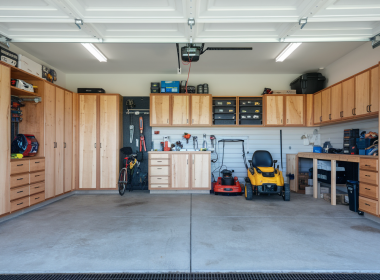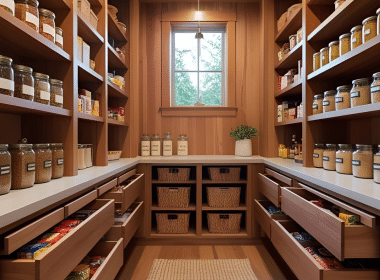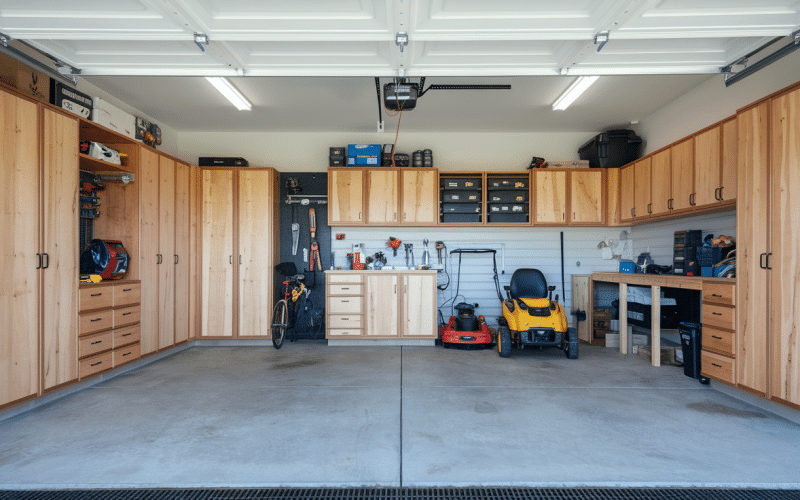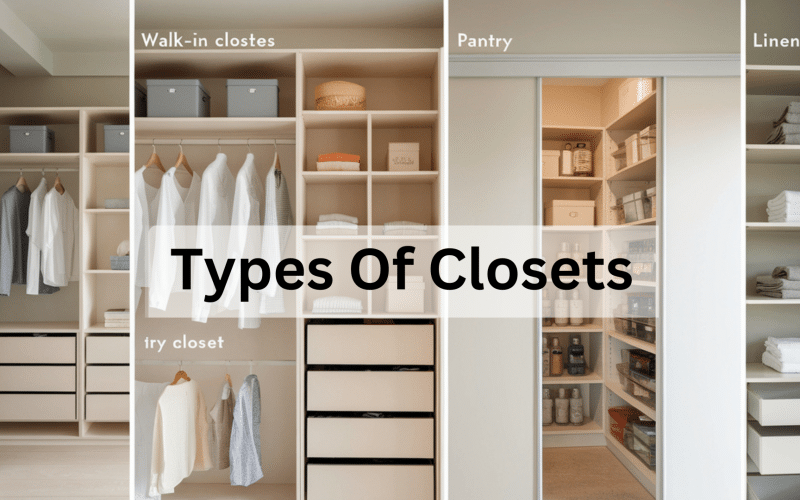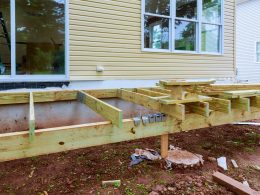Is your garage filled with random boxes, tools, and holiday decorations, taking up valuable space? Wood garage cabinets offer a simple solution to transform this chaos into order.
These practical storage options come in many styles to match both your space limits and personal taste.
With the right cabinets, you can easily find what you need when you need it, saving time and reducing stress.
This guide walks you through what matters most when choosing wood cabinets for your garage.
We’ll cover size options, materials, cost considerations, and setup tips to help you make an informed choice.
Why Choose Wood Garage Cabinets?
Wood garage cabinets offer many benefits that make them a popular choice for homeowners.
When you’re thinking about how to organize your garage, the material you choose matters a lot.
Benefits of Wood Over Metal and Plastic
Wood cabinets feel warmer, quieter and hold up better against temperature swings.
They’re also easy to adjust if you need to make small changes or add features.
| Feature | Wood Cabinets | Metal Cabinets | Plastic Cabinets |
|---|---|---|---|
| Look and Feel | Warm and home-like; blends with indoor spaces | Industrial and cold appearance | Basic and lightweight look |
| Noise Level | Quiet when opening and closing | Can be loud or clangy | Quiet, but doors may be flimsy |
| Temperature Handling | Feels steady in hot or cold garages | Gets hot in summer and cold in winter | Doesn’t hold heat or cold, but it may warp |
| Ease of Custom Changes | Easy to adjust or drill for hooks and shelves | Harder to change without special tools | Often not strong enough to be modified |
| Strength and Durability | Strong and stable when well-built | Very strong and long-lasting | Less durable over time |
| Price Range | Mid-range to high, depending on wood type | Often high, but worth it for long-term use | Usually cheaper, good for light storage |
| Best For | Tools, sports gear, general use | Heavy-duty tools and rough environments | Light items, kids’ stuff, seasonal storage |
Types of Wood Used in Garage Cabinets
- Engineered Wood: This includes plywood, MDF (Medium-Density Fiberboard), and particle board. These materials are made from wood fibers bonded together. They’re often less expensive than solid wood but can still be very strong and useful.
- Plywood: Plywood consists of thin layers of wood glued together. It’s strong and doesn’t warp easily, making it good for garage use where humidity might change.
- MDF: MDFis smooth and works well for cabinet doors and shelves. It’s made from very fine wood fibers pressed together, creating a dense, flat surface that’s perfect for painting.
- Particle board: This is the most budget-friendly option. It’s made from wood chips and sawdust held together with glue. While not as strong as other options, it works well for light storage needs.
- Solid Wood: This is wood cut directly from trees. Oak, maple, and pine are common choices. Solid wood cabinets tend to cost more but can last for generations with proper care.
- Oak: Oak is strong and has a distinct grain pattern that many people find attractive. It holds up well to daily use.
- Maple: Offers a smooth, even grain and takes paint well. It’s very hard, making it resistant to dents and scratches.
- Pine: Pine is softer and less expensive than oak or maple. Some homeowners prefer its rustic look for their garage space.
Types of Wood Cabinets for Garages to Choose From

When selecting a product, focus on quality materials, functional design, reliability, user reviews, and cost-to-value ratio.
Consider how it meets your specific needs, check technical specifications and ease of use, plus verify customer support and warranty coverage.
Cabinets
This type of storage unit can be moved if you rearrange your garage, giving you more flexibility.
It doesn’t need to be mounted to a wall, which is helpful in garages that have concrete surfaces.
These units often provide more storage space compared to wall-mounted options.
However, it’s important to secure them properly to avoid tipping, especially if you have children or store heavy items.
Wall-Mounted Cabinets
Overhead storage can help free up floor space, making it easier to park cars or keep the area clear for other items.
It’s especially helpful in places where flooding might occur, as it keeps everything off the ground.
These storage options are usually smaller and may not hold heavy or bulky items. They also need to be securely attached to wall studs for safe use.
Door Cabinets
Box storage systems offer practical benefits for storing large items such as packages and substantial tools.
When you open these systems, they provide a complete view of all contents simultaneously, making item selection straightforward.
These storage options generally cost less compared to drawer-based alternatives.
Additionally, they function effectively with adjustable shelving, accommodating items of various dimensions.
Drawer Cabinets
Small items that might get misplaced work well in drawer systems.
These storage options offer improved organization through the use of dividers, letting you sort and separate your belongings effectively.
Drawer systems provide better protection against dust compared to traditional door-style cabinets.
They also allow you to access what you want directly without having to shift other objects out of the way first.
For an ideal storage arrangement, consider using both types: drawers for smaller items and door cabinets for bigger equipment.
This combination creates a practical and efficient storage solution for all your needs.
Dimensions That Matter
The aspects that truly matter exist in multiple dimensions, shaping our lives in ways we often fail to notice.
Common cabinet sizes include:
- Wall cabinets: 24″ to 48″ wide, 12″ to 16″ deep, 24″ to 42″ tall
- Base cabinets: 24″ to 48″ wide, 16″ to 24″ deep, 34″ to 36″ tall
- Tall cabinets: 24″ to 36″ wide, 16″ to 24″ deep, 60″ to 84″ tall
When measuring your space:
- Check ceiling height (for tall cabinets)
- Measure wall width, noting any obstacles like light switches
- Check how far the cabinet can stick out without blocking cars
- Leave room for doors to swing open
- Account for your car’s doors opening if you park in the garage
How to Choose the Right Cabinet for Your Garage
From size and material to organization features, your choice will impact both functionality and longevity.
Storage Needs Assessment
When selecting storage solutions, consider what items need organization.
For tools, think about units with drawers for smaller items and cabinets with adjustable shelves for larger power equipment.
Those who need to store garden supplies might benefit from taller storage options that accommodate tools with long handles.
Sports equipment works well in storage units featuring hooks on the interior of the doors, which allows for efficient use of space.
For items used only during certain times of the year, look for deep storage options with strong shelves to maximize your available area.
Before making any purchases, it’s helpful to sort your belongings by category and dimensions to ensure you select the most appropriate storage solution for your needs.
Color Options for Wood Garage Cabinets
Wood garage cabinets are available in various colors to suit different spaces and preferences.
White cabinets can make your garage feel brighter and more spacious, though they may show dirt and marks more clearly.
Black cabinets effectively hide soil and grime but might cause your garage to appear smaller.
Wood-grain finishes offer a natural appearance and tend to mask scratches more effectively.
Gray cabinets provide a contemporary look while concealing dirt at a reasonable level.
Factors to Consider When Selecting Cabinet Colors
Your selection of cabinet colors should be based on several important considerations.
Think about the typical cleanliness of your garage environment. Consider how the cabinet color will coordinate with your existing wall and floor colors.
The amount of natural light that enters your garage will affect how colors appear.
Finally, your personal color preferences will play a significant role in making a satisfying choice that works well for your specific garage situation.
Self-Assembly Wood Option
Most wood garage cabinets are shipped flat-packed for home assembly by the buyer.
To complete the job, you’ll need some basic tools, including a screwdriver, a hammer, and measuring tape.
The time commitment varies based on the cabinet size and complexity, typically ranging from 1 to 3 hours for each unit.
Having someone assist you with the process can significantly reduce the work time and make handling larger pieces much more manageable.
Factory-Assembled Wood Selection
Paying extra for pre-assembled cabinet units saves considerable time and eliminates potential assembly issues.
Be aware that shipping costs increase substantially due to the larger package dimensions.
It’s important to measure your garage entrance carefully, as these assembled units might not fit through standard garage doors or hallways.
A benefit of factory assembly is often the superior construction quality, as professional equipment and techniques are used during manufacturing.
Installation Tips for Wood Garage Cabinets
Anchoring Cabinets Safely
Wall cabinets must be secured to wall studs for proper support.
Use a stud finder to locate the studs, which are typically positioned 16 inches apart in most homes.
When working with concrete walls, masonry anchors provide the necessary strength for mounting.
Tall, freestanding cabinets should be attached to walls to stop them from tipping forward, which can cause injury or damage.
It’s recommended that heavier items be stored in bottom drawers and on lower shelves for better stability and balance.
Protecting Wood from Garage Humidity
Moisture protection starts with sealing any raw wood edges using paint or appropriate sealant.
Install cabinets with adjustable feet to maintain distance between the units and potentially damp floors.
In particularly humid environments, adding a dehumidifier can help maintain optimal conditions for wooden components.
Applying furniture wax to cabinet exteriors annually creates an additional barrier against moisture.
Regular inspections for garage leaks and prompt repairs will prevent water damage and extend the life of your wooden cabinets.
Maintenance & Care for Wood Garage Cabinets

Regular upkeep keeps your items in top condition. Simple attention to basic care will extend the lifespan of your products.
Cleaning Tips for Engineered Wood
- Wipe with a slightly damp cloth (not soaking wet)
- For sticky spots, use mild dish soap diluted with water
- Dry immediately after cleaning to prevent swelling
- Avoid harsh chemicals that can damage laminate finishes
- Use furniture polish sparingly (once every few months)
Preventing Warping or Damage
Cabinet maintenance requires attention to weight distribution and placement.
Do not place excessively heavy items on shelves, and always check the specified weight limitations for each shelf.
Spread the weight uniformly across all shelves rather than concentrating it in one area for maximum stability and longevity.
Position your cabinets away from direct heat sources, as heat can cause materials to warp or crack over time.
When liquids spill, quick action is essential—clean them up right away to prevent moisture from seeping into the wood and causing lasting damage.
Regular maintenance should include checking fasteners and tightening any screws that may have come loose with normal use.
These simple practices will help extend the life of your cabinets significantly.
Where to Buy Wood Garage Cabinets
The best places to purchase wood garage cabinets are home improvement centers, specialized storage retailers, online marketplaces, and custom cabinet makers.
Best Online Retailers
- Amazon offers diverse options, simple return processes, and helpful user feedback.
- Wayfair features frequent promotions, complete product information, and tools to see items in your space.
- Home Depot/Lowe’s allows in-store collection and access to knowledgeable staff.
- Costco provides competitive pricing on available models and an outstanding satisfaction guarantee.
Things to Check Before Purchase
Before buying, it’s important to understand several key factors.
First, check the store’s return policy and available shipping methods for your area.
Confirm the steps for setup, and pay close attention to the weight restrictions for each shelf.
Be aware of warranty duration and specific coverage details.
Finally, browsing customer feedback will give you insight into stability and setup difficulty, helping you make an informed choice.
Final Thoughts
Wood garage cabinets provide a practical way to organize your space.
They combine good looks with strength and can be more easily adapted to fit specific needs than metal alternatives.
When you have the right storage system, your garage stays organized, and finding tools becomes simple.
With basic maintenance, wood cabinets remain attractive and useful for years to come.
Your garage doesn’t need to be just a place for your car—with the right cabinets, it can become a clean, organized space that works for you and your family.
Share your views in the comments below!

